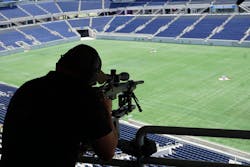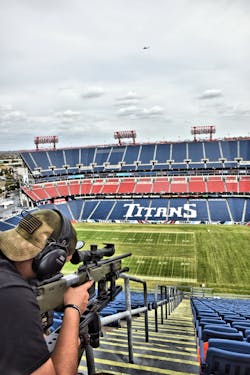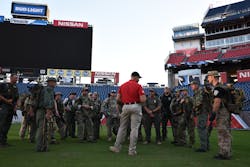It’s hard to look at the events of Oct. 1, 2017 in Las Vegas and not see the immediate and forthcoming effects of how SWAT teams will deal with special events. We no longer live in a world where large events can be ignored or treated in a conventional response model.
The bad guys have changed their tactics and law enforcement’s specially trained best will be called on like never before moving forward. SWAT team placement at large-scale events and public venue locations is already becoming more common—the Las Vegas Criminal Sniper event has, in effect, kicked the deployment of SWAT resources into high gear all around the country. SWAT teams, both large and small, must continue to push the envelope in training, equipment and tactics to combat the threats to protect our citizens.
This is the new normal.
Several obstacles in place now
There is no better word than “reactive” to describe the history of law enforcement. A tragedy occurs and law enforcement arrives and deals with the aftermath. Law enforcement has been so mired in reactive policing that sometimes many do not realize that with proper planning and a proactive approach it’s possible to get out in front of potential mass casualty events. For larger agencies this may have already been in place, but for many smaller agencies this may be the status quo. Large events that are not looked at through the terrorist’s optics are conversely not planned for with that very threat in mind.
Another obstacle many teams face is limited manpower. Dependent upon the frequency of the large scale events, teams may be overtaxed to perform such duties. The preponderance of SWAT teams in the U.S. are made up of Collateral Duty and Multi-Jurisdictional teams according to the National Tactical Officers Association. Those teams are the norm, full-time SWAT teams are the exception. Coupled with the trend over the last 10 to 15 years to intentionally trim down SWAT teams, administrators now find themselves in a bind with current events.
SWAT deployment at large scale events and public venues has only recently fallen into regularity and some teams find that their current resources are pushed to the limit to fulfill special event requests. The event of Oct. 1 in Las Vegas has directly impacted SWAT teams being requested far more than they were in the past. As many more events are worked by SWAT teams there will have to be serious discussion and creative thinking to accommodate all the requests and needs.
The obvious solution is enlarging SWAT teams to a size that will allow for working the increased special events details and not burning out the team or preventing them from serving their jurisdiction when called on to do so. Many teams can handle an event, but if there is a callout before, afterwards or during the event, it will task members disproportionately depending on team makeup, relief factor and/or mutual aid agreements. Running SWAT members physically and mentally into the ground with a high operational tempo is not a good recipe.
Differing SWAT roles and functions
In order to address the above challenges, we must first look at the basic functions that SWAT teams can provide at public events, including Police Sniper Overwatch and Quick React Teams (QRTs).
Police Sniper Overwatch has been pushed to the forefront since Oct. 1. An effective Police Sniper program that is well-versed in deployment tactics, rifle platforms and large caliber capabilities can be the difference in mitigating a mass casualty event.
QRTs are invaluable in their ability to quickly push to threats and apply the correct solution dependent on the threat. These teams may consist of four to eight SWAT personnel and may be accompanied by Rescue Vehicles (Lenco Bearcat, etc.). QRTs may also deploy via SUVs and have the ability to move amongst large crowds and go on foot to contact individuals or areas on their own or where Overwatch teams direct them.
Another consequential asset is Aerial Platform Overwatch. The ability to place a trained SWAT operator into a helicopter during a pre-planned event is a prodigious asset in securing the safety at these events. Consider partnering your SWAT and the Helicopter Units together to establish an Aerial Platform program. What may have been seen in the past as not necessary can no longer not be justified with current threats. Effective Aerial Platform deployment can also potentially allow for threat mitigation for Criminal Sniper events that are elevated such as in the two prominent incidents at Austin, Texas in 1966 and Las Vegas in 2017.
The threat environment at these events can include all the following: active shooter, criminal sniper, edge weapon attack, vehicle ramming attacks, improvised explosives, suicidal bomber, vehicle improvised explosives, radiological/nuclear attack and chemical/biological attack. With such a variety of attack methods, SWAT teams should be training in a manner that can address a response to these various styles. Some attack methods are more mainstream than others currently, but the mistake is believing that not all could occur at large scale/public venue events.
Train for new criminal tactics
Conventional callouts with subjects that will not come out of locations has been the bread n’ butter of SWAT for decades, however, that’s changing. SWAT teams are tasked with training for more threats than at any time before in their history. SWAT operators are a reflection of their training and will rarely perform a new skillset or task with great precision if it has not been practiced. Any SWAT problem should be trained before encountering it in an operation or crisis.
There are several areas that can increase the likelihood of operational success, and live-fire precision rifle training for police snipers is one such example. There can be huge confidence considerations and formal documentation provided for teams that get away from the range and find areas to do off-site live fire training. Training at selected venues where large-scale events are held is also very valuable for teams. Incorporating Reality Based Training (RBT) at these venues allows for increased knowledge of the venues and training the mental aspect for each SWAT operator.
Visualizing where a crisis may occur is one thing. Training for the crisis at the venue is another and is a best practice. Teams will need to increase training outside their current comfort zone and seek out training providers skilled in the current threats and those yet to come. Inbred training—learning only from fellow team members—will not necessarily serve the team or public well. SWAT teams must always strive for an open-minded approach to new Techniques, Tactics and Procedures.
Establish a deployment matrix
With the influx of special event requests for SWAT deployment, it is advisable to have a deployment matrix established to not only guide when to deploy, but also protect law enforcement from scrutiny and/or potential litigation for not having done so. Commanders and/or politicians arbitrarily deciding which events to work are a non-issue when they are not numerous, however, in larger cities and areas where multiple public venues exist, the issue can be quite different.
As discussed earlier, limited manpower can be a factor in not providing SWAT resources. The National Special Event Assessment Rating can be a guide for deployment, but is not necessarily geared towards smaller events and SWAT teams that may get asked to provide assets. A deployment matrix can address areas such as projected attendance, type of event, criminal intelligence, dignitary presence, threat assessment and mass transit proximity and provides as a basis for allocating when to deploy SWAT resources. Similar to a threat matrix for warrant service and callouts, it should be considered a best practice moving forward.
Consider the venue and event
An area that many in law enforcement don’t often get insight into is the venue industry and specifically the event organizers. Post Oct. 1, 2017 and the Route 91 Harvest Festival, organized security is at the forefront of event planning. Event organizers are in a challenging era where security costs have skyrocketed and must be measured against past security attacks and threats that could occur at their event.
In my experience, ‘keep my family safe’ is an attendee mandate. Conventional decisions in the past to limit the visibility of SWAT members in BDUs, rifles in view and armored rescue vehicles hamper a SWAT teams’ ability to secure these events properly. The pendulum of “the militarization of the police” that swings back and forth is generally welcomed at these events. Many could care less about what metamorphosis the SWAT team takes on while there. In fact, in my experience, the majority of the public welcomes a show of force and will go out of their way to speak to SWAT officers and thank them for being there. Keep in mind, your show of force may keep an attack from even occurring—a metric that is immeasurable.
This is the new normal.
Ideally, law enforcement SWAT teams would work with event organizers many months prior to an event and stress the importance of showing a SWAT presence.
Avoid past mistakes
Philosopher George Santayana stated, “Those who cannot remember the past are condemned to repeat it.” In the case of the criminal sniper event in Las Vegas, a similar event occurred some 51 years before at the University of Texas. A person in an elevated position took lives for a sustained period before law enforcement could bring it to an end. The parallels between the two are tangible. The failure to remember and train for what occurred in 1966 was brought to bear in 2017.
It could have easily occurred in Anywhere Town in Anywhere USA. We must be students of history and never forget that evil will rear itself from time to time.
About the Author
Mark Lang has spent nearly 27 years as a police officer with the Dallas Police Department. During a large part of this time he has been a member of Dallas SWAT with a specialty of Police Sniper. He is a Lead Sniper Instructor for TacFlow Academy. He can be reached at [email protected].
About the Author

Mark Lang
Mark Lang is the Director of Sniper Training for Tacflow Academy. Nearing a 30-year career in law enforcement he has spent a majority of it as a member of a Tier 1 Full-time SWAT team in North Texas. He has developed proprietary training curriculum in the areas of Public Venue Response & Deployment, Large Caliber Rifle Instructor and Aerial Platform Operations. A member of the America Sniper Association and the National Tactical Officers Association Sniper Section Committee he writes and contributes to several media outlets to increase awareness for police snipers, SWAT personnel & SWAT Supervision. He is also the CEO of Venue Safety Consulting and can be reached at [email protected]



